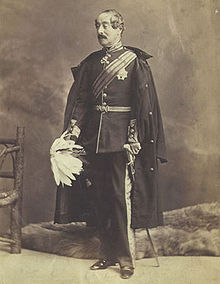Charles Hastings Doyle
General Sir Charles Hastings Doyle | |
|---|---|
 | |
| Colonial Lieutenant Governor of Nova Scotia | |
| In office 17 September 1863 – 8 November 1865 | |
| Monarch | Victoria |
| Premier | James W. Johnston Charles Tupper |
| Governor | The Viscount Monck |
| Preceded by | George Phipps, 2nd Marquess of Normanby |
| Succeeded by | Richard Graves MacDonnell |
| 2nd Lieutenant Governor of Nova Scotia | |
| In office 18 October 1867 – 1 May 1873 | |
| Monarch | Victoria |
| Governor General | The Viscount Monck The Lord Lisgar |
| Premier | Hiram Blanchard William Annand |
| Preceded by | Sir William Williams, 1st Baronet, of Kars |
| Succeeded by | Joseph Howe |
| 1st Lieutenant Governor of New Brunswick | |
| In office 1 July 1867 – 18 October 1867 | |
| Monarch | Victoria |
| Governor General | The Viscount Monck |
| Premier | Peter Mitchell Andrew Rainsford Wetmore |
| Preceded by | Arthur Hamilton-Gordon, 1st Baron Stanmore |
| Succeeded by | Francis Pym Harding |
| Personal details | |
| Born | 10 April 1803 London, England |
| Died | 19 March 1883 (aged 79) London, England |
Sir Charles Hastings Doyle, KCMG (10 April 1803[1] – 19 March 1883) was a British military officer and he was the second Lieutenant Governor of Nova Scotia post Confederation and the first Lieutenant Governor of New Brunswick.
Military career[]
Born in London, England, the eldest son of Lieutenant-General Sir Charles William Doyle and Sophia Cramer Coghill, he attended the Royal Military College, Sandhurst, and joined the army as an ensign of the 24th (The 2nd Warwickshire) Regiment of Foot on 23 December 1819. He was promoted to the ranks of lieutenant on 27 September 1822 and captain on 16 June 1825. He received a brevet-major on 28 June 1838. Rising through the ranks, he reached major general in 1860.

After service in the Crimean War, he was stationed in Nova Scotia and, during the American Civil War, resolved the Chesapeake Affair, which took place in Halifax. Next Charles Hastings Doyle countered the threat of Fenian Raid on Canada's Maritime Provinces by ending the Campobello Island Raid (1866). By April 1866 the menace of a Fenian invasion of New Brunswick was at its most serious, and Doyle quickly responded to Lieutenant Governor Gordon's request for military aid. On 17 April 1866, he left Halifax with Royal Navy warships carrying over 700 British regulars and proceeded to Passamaquoddy Bay, where the Fenian force was concentrated, under the command of John O'Mahony. This show of British armed might discouraged the Fenians, and the invaders dispersed.[2]
He was appointed the Lieutenant-Governor of New Brunswick in 1867, the first Lieutenant Governor of New Brunswick after Confederation. From 1867 to 1873, he was the second Lieutenant Governor of Nova Scotia post-Confederation. In 1869, he was promoted to lieutenant general and appointed a Knight Commander of St Michael and St George. He became Commander of the British Troops in Canada in 1870[3] and general officer commanding Southern District in April 1874.[4] He was promoted full general in 1877.[5]
There is a full-length portrait of him by in Province House (Nova Scotia). He is the namesake of Port Hastings, Nova Scotia.
Awards and decorations[]
![]()
See also[]
References[]
- ^ Boase, Frederic (1892). Modern English Biography: A-H. p. 911. (Many sources give Charles Hasting Doyle's date of birth as 10 April 1804 – the year 1804 is definitely wrong because Charles Hasting Doyle's brother John Sydney Doyle was born in May 1804.)
- ^ McDonald, Ronald H. (1982). "Doyle, Sir Charles Hastings". In Halpenny, Francess G (ed.). Dictionary of Canadian Biography. Vol. XI (1881–1890) (online ed.). University of Toronto Press.
- ^ Hart's Army List for 1871, p. 546; for 1872, p. 546; for 1873, p. 546.
- ^ "Army Commands" (PDF). Archived from the original (PDF) on 4 March 2016. Retrieved 21 November 2015.
- ^ "No. 24445". The London Gazette. 20 April 1877. p. 2676.
Sources[]
- Hart, H.G. 1841. The New Army List. London.
- Paton, G. 1892. Historical Records of the 24th Regiment. London.
- 1804 births
- 1883 deaths
- Military personnel from London
- British Army generals
- Knights Commander of the Order of St Michael and St George
- Lieutenant Governors of New Brunswick
- Lieutenant Governors of Nova Scotia
- Governors of the Colony of Nova Scotia
- Graduates of the Royal Military College, Sandhurst
- British Army personnel of the Crimean War
- Military history of Nova Scotia
- South Wales Borderers officers